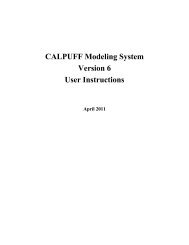Volume 1 - The Atmospheric Studies Group at TRC
Volume 1 - The Atmospheric Studies Group at TRC
Volume 1 - The Atmospheric Studies Group at TRC
You also want an ePaper? Increase the reach of your titles
YUMPU automatically turns print PDFs into web optimized ePapers that Google loves.
the numbers refer to ICOARE values, and the “d” and “s” refer to the deep-w<strong>at</strong>er and<br />
shallow-w<strong>at</strong>er Charnock parameter limits.<br />
CALMET must be started no l<strong>at</strong>er than the hour th<strong>at</strong> ends <strong>at</strong> 0500 in the base time<br />
zone (typically LST) and it does not need to cre<strong>at</strong>e meteorological fields for hours<br />
after the end of sampling, since no CALPUFF simul<strong>at</strong>ions are made after the<br />
sampling termin<strong>at</strong>es. <strong>The</strong>refore each experiment-day is simul<strong>at</strong>ed in a separ<strong>at</strong>e<br />
CALMET applic<strong>at</strong>ion.<br />
<strong>The</strong> fumig<strong>at</strong>ion study <strong>at</strong> Carpinteria is made up of several ½-hour periods instead of<br />
the one-hour periods used in the other d<strong>at</strong>asets. <strong>The</strong>se are simul<strong>at</strong>ed as one-hour<br />
experiments. On 10/4/1985 and 10/5/1985, three contiguous ½-hour sampling and<br />
meteorological averaging periods must be addressed (10:00, 10:30, 11:00). This is<br />
done by making two simul<strong>at</strong>ions of each day, with Hour 11 set to the 10:30 period in<br />
one, and 11:00 in the other. Hour 10 is period 10:00 in both runs.<br />
Oresund<br />
Emphasis is given to using all available measured winds and temper<strong>at</strong>ures <strong>at</strong> sites<br />
upwind of, across, and downwind of the strait of Oresund. Unlike most regular<br />
CALMET applic<strong>at</strong>ions, there is a wealth of d<strong>at</strong>a on the vertical structure. <strong>The</strong>refore,<br />
CALMET is configured to NOT extrapol<strong>at</strong>e the surface observ<strong>at</strong>ions. Winds in the<br />
UP.DAT files are given primary influence on the tracer transport and dispersion of<br />
these elev<strong>at</strong>ed releases.<br />
Over the Oresund itself, the boundary layer structure is characterized by the wind<br />
speed, air-sea temper<strong>at</strong>ure difference, rel<strong>at</strong>ive humidity and vertical temper<strong>at</strong>ure<br />
gradient listed in the SEA.DAT file. <strong>The</strong> overw<strong>at</strong>er mixing height is taken directly<br />
from the SEA.DAT file and tre<strong>at</strong>ed as an observ<strong>at</strong>ion when it is provided, or it is<br />
computed when it is not provided. CALMET is run both with and without estim<strong>at</strong>ed<br />
overw<strong>at</strong>er mixing heights. Over land, the boundary layer structure is characterized<br />
by the wind speed and cloud cover listed in the SURF.DAT file, along with the<br />
gridded surface characteristics contained in the geophysical d<strong>at</strong>a file th<strong>at</strong> account for<br />
land use vari<strong>at</strong>ions. <strong>The</strong> daytime mixing height over land includes the history of the<br />
computed surface fluxes and accounts for the modific<strong>at</strong>ion of the temper<strong>at</strong>ure<br />
structure aloft provided in the UP.DAT files. Note th<strong>at</strong> all mixing heights (over land<br />
and over w<strong>at</strong>er, whether computed or provided in the SEA.DAT file) are modified for<br />
advection affects which includes both off-shore and on-shore flow in this study.<br />
Altern<strong>at</strong>e methods for computing mixing heights are selected to explore the<br />
sensitivity of model performance to these choices. Overw<strong>at</strong>er mixing heights are<br />
either provided in the SEA.DAT file (these heights are listed in Table 4-10), or<br />
computed internally. Whenever the mixing height is computed (land or w<strong>at</strong>er) and<br />
the surface he<strong>at</strong> flux is positive, either the modified Maul-Carson model is used<br />
Final Report Vol.1 57







